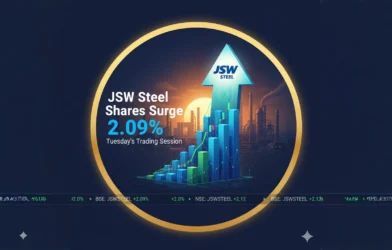Author: Aditya Pareek | EQMint | General News
Shares of Wipro Ltd., one of India’s leading IT services companies, fell sharply on Friday, October 17, after the company’s September quarter (Q2 FY25) earnings announcement failed to impress the market. The stock declined over 4.4%, trading around ₹242.8, following results that were released post-market hours on Thursday. The fall came despite a largely in-line performance and steady deal bookings, indicating cautious investor sentiment toward the IT major’s near-term growth prospects.
Wipro’s American Depositary Receipts (ADRs) listed in the US had also closed 2.5% lower overnight, signaling that global investors were bracing for muted optimism even before Indian markets opened.
The Q2 results triggered a wave of mixed reactions among analysts. Of the 47 analysts tracking Wipro, 16 maintained a “sell” rating, 13 recommended a “buy”, and 18 advised a “hold.” The divergence of opinions underscores the market’s uncertainty over Wipro’s earnings trajectory and its ability to sustain growth amid a volatile global technology environment.
Q2 Snapshot: Margins Hold, Deal Wins Continue
According to its Q2 report, Wipro managed to deliver results broadly in line with expectations. The company recorded strong deal bookings, indicating continued traction in client engagement and contract closures across key geographies.
Even though topline growth remained subdued, the company’s Earnings Before Interest and Tax (EBIT) margin held steady, as management reaffirmed its goal to maintain margins within a narrow band despite ongoing macroeconomic challenges and demand softness in key verticals.
However, market participants appeared more focused on the near-term revenue guidance, which remained conservative. Wipro projected its Q3 FY25 revenue to be between a growth of 1.5% and a decline of 0.5% on a constant currency (CC) basis. The company clarified that this guidance excludes potential contributions from its recent acquisition of Harman Digital Transformation Solutions, which is still being integrated.
While deal momentum was seen as encouraging, the company’s outlook hinted that recovery in discretionary tech spending across global clients remains uneven.
Nomura: Confident with a ‘Buy’ Call, Sees Upside Ahead
In its post-results review, Nomura maintained a “buy” rating on Wipro and set a price target of ₹280 per share, implying a potential upside of around 10% from Thursday’s closing level.
Nomura highlighted that Wipro’s Q2 performance “beat expectations on most parameters,” particularly in deal wins and margin resilience. The brokerage noted that the management’s commitment to operational discipline, combined with stable profitability, positions the company well for gradual improvement in coming quarters.
The Japanese brokerage also emphasized Wipro’s attractive dividend yield of around 4% for FY27, and pointed out that the stock is currently trading at 19.8 times its estimated FY27 earnings-per-share (EPS)—a valuation that it considers reasonable given Wipro’s strong cash generation and improving business mix.
Nomura’s analysts expressed confidence in Wipro’s ongoing transformation efforts under its leadership, citing continued client additions and digital-focused project expansion as positive signs for medium-term growth.
Jefferies: Stays Cautious with ‘Underperform’ Rating
On the other hand, Jefferies retained its “underperform” rating on Wipro, setting a target price of ₹220, implying a downside potential of more than 13% from the stock’s last close.
While the brokerage acknowledged that the Q2 results were “in line with estimates,” once adjusted for a ₹120 crore one-time charge, it remained cautious about the stock’s future returns.
Jefferies noted that Wipro’s strong deal wins and improved order bookings signal a modest recovery in client sentiment, yet warned that overall revenue growth visibility remains limited.
The global brokerage expects Earnings Per Share (EPS) to grow at a Compounded Annual Growth Rate (CAGR) of just 3% between FY26 and FY28. Coupled with an estimated 3% dividend yield, Jefferies believes the risk-reward equation appears “unattractive” at current valuation levels.
The firm added that Wipro’s growth is likely to lag peers in the near term due to execution challenges and limited scale benefits compared to larger IT service players such as TCS and Infosys.
Mixed Analyst Reactions Across the Street
The divide in analyst opinions reflects the broader uncertainty that continues to cloud India’s IT sector. Many firms believe that while the worst of the global technology slowdown may be behind, a clear demand revival has yet to emerge.
For Wipro, this ambiguity has translated into uneven performance over the past few quarters. While it has managed to secure large deals and maintain margin stability, it has struggled to deliver consistent revenue acceleration—a key metric that investors watch closely.
Some analysts suggest that the market may be underestimating Wipro’s ability to benefit from an eventual recovery in global IT spending, while others argue that the company’s growth trajectory still lacks visibility and momentum.
Wipro’s management has maintained an optimistic tone, pointing to strong deal pipelines, efficiency measures, and focused investments in high-growth areas such as cloud, AI, and cybersecurity. However, until these initiatives start reflecting meaningfully in quarterly numbers, investor skepticism is likely to persist.
Market Reaction and Outlook
The sharp decline in Wipro’s stock on Friday indicates that investors were looking for a stronger signal of growth revival. The subdued guidance for Q3, despite steady deal wins, may have triggered profit-taking, particularly after a modest run-up in the stock earlier this quarter.
Market experts noted that the IT sector overall is facing mixed conditions. While cost optimization projects and digital transformation mandates continue to drive demand, new project ramp-ups and discretionary spending remain sluggish due to global macroeconomic uncertainties.
For long-term investors, Wipro remains a stable yet slow-moving player. Its dividend yield, strong balance sheet, and consistent cash flow offer comfort, but in the absence of strong growth acceleration, the stock’s upside potential appears capped in the short term.
The Road Ahead
As Wipro looks toward the second half of FY25, its focus will likely remain on deepening client relationships, enhancing operational efficiencies, and integrating its new acquisitions to strengthen its digital transformation portfolio.
While the company’s fundamentals remain sound, analysts caution that meaningful re-rating in the stock may depend on stronger revenue visibility and a more confident demand outlook from global clients.
For now, the market appears to be adopting a “wait and watch” stance—acknowledging Wipro’s steady performance but holding back enthusiasm until growth momentum becomes more evident.
Disclaimer: This article is based on information available from public sources. It has not been reported by EQMint journalists. EQMint has compiled and presented the content for informational purposes only and does not guarantee its accuracy or completeness. Readers are advised to verify details independently before relying on them.









